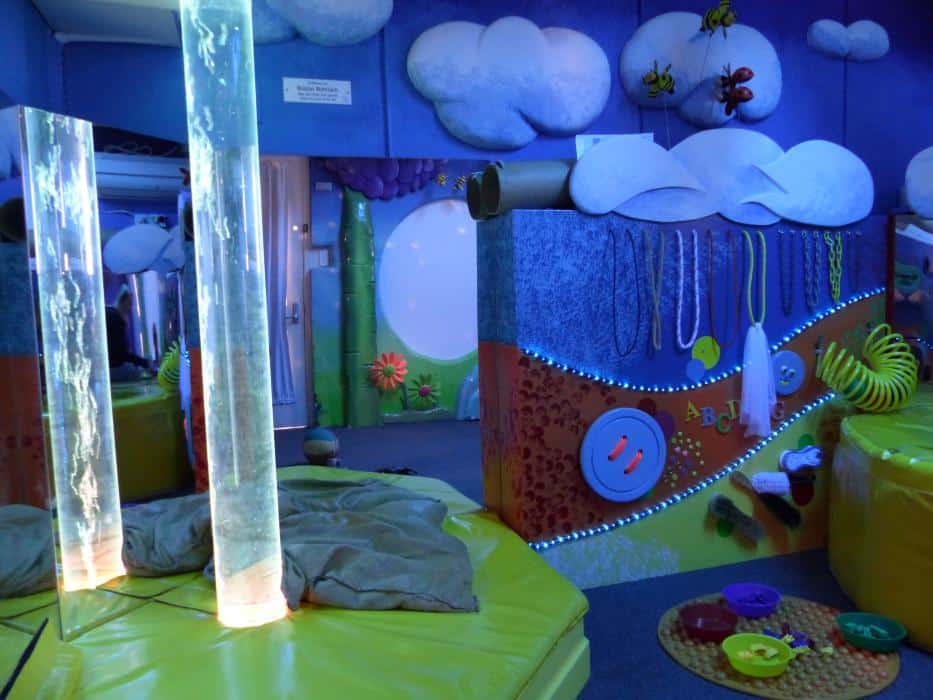
Liliya John is a researcher for Altogether Autism
17 March 2017 – A multi-sensory environment is an artificially created room or space designed to allow those using it to control sensory input, including sound, lighting, smell, touch, temperature and space. Multi-sensory equipment is used to stimulate the senses and promote pleasing sensation and feelings of well-being.
The origin and history of multi-sensory rooms can be traced back to the Netherlands in the late 1970s where psychologists Ad Verheul and Jan Hulsegge developed them as a therapy for individuals with severe disabilities.
Originally named as ‘Snoezelen’ by the founders, it is now being widely referred to as ‘multi-sensory rooms’ or ‘multi-sensory environments’ (MSE). The term “snoezelen” (pronounced like “SNOOzelen”) is a neologism formed from the Dutch “snuffelen” (to sniff, to snuffle) and “doezelen” (to doze, to snooze).
Over the years, the concept has become popular in the UK and Europe where multi-sensory environments provide a wide range of sensory stimulation for people with a variety of disabilities, disorders and conditions, and are a part of special education curriculums.
Those who can benefit from multi-sensory environments include children and adults with learning differences such as autism, cerebral palsy, intellectual and multiple disabilities, people with brain injuries, dementia sufferers, and people with mental health issues including stress or anxiety problems.
A multi-sensory environment is an artificially created area, such as a room or a pool or a garden, which contains equipment and materials designed to stimulate the senses through light, sound, touch and smell.
It aims to create a feeling of safety, and to provide novel sensations, with stimulation being under the user’s control. Items used in multi-sensory environments include things like ball pools, bubble tubes, optic fibre taillights and musical effects in one place. Multi-sensory rooms do not rely on verbal communication and may be beneficial for people with profound autism, as it may provide stimulation for those who would otherwise be almost impossible to reach.
Providing a stimulating environment can:
- Increase concentration and focus attention
- Develop or reactivate senses of hearing, sight, smell, touch, and taste
- Heighten awareness and improve alertness
- Improve coordination and motor development
- Promote cognitive development by increased brain function
- Lead participants to explore their environment
- Provide security
- Be an unrestrained atmosphere where participants feel able to enjoy themselves.
- Improve creativity
- Stimulate the sensory building blocks
- Develop of a sense of cause and effect
- Develop language – more vocalization
- Promote social interactions
- Promote mental and physical relaxation – Stress levels drop dramatically
- Result in more calmness and lower aggressive behaviours
- Increase opportunity for choice and self-determination
- Improve communication and sharing
- Lead to non-responsive patients becoming communicative
- Provide relief from pain and painful physiotherapy

Multi-sensory room at the MacKenzie Centre, an early intervention centre in Hamilton, New Zealand
What is a multi-sensory garden?
A multi-sensory garden is a garden environment designed with the purpose of stimulating the senses.
This stimulation occurs through plants and the use of materials that engage one’s senses of sight, smell, touch, taste, and sound. These types of gardens are popular with both children and adults, especially those who have sensory processing issues, including autism and other disabilities.
Recent research on sensory gardens showed promising results for children with developmental disabilities. In one study, researchers attempted to study the influence of a sensory garden on a sample of children with special education needs. The findings showed a sensory garden provided students with a stimulating experience and positively influenced their behaviour and development in terms of social relationships (Hussain, 2012).
A recent study evaluated the outcomes of outdoor play using a multiple baseline research design. Positive treatment outcomes were seen in a clinical treatment setting (McConkey, 2016).
What does the research say about multi-sensory environments and autism?
Research is scarce on the effectiveness of multi-sensory environments among people with autism and findings are mixed. Two studies found positive results for people on the spectrum. Research carried out in Brussels attempted a comparative study of the behaviour of nine adults with profound autism in both classroom and multi-sensory room settings. There were variations in individual results but a 50 per cent reduction in distress and stereotypical behaviour and 75 per cent less aggression and self-injury in the sensory room environment (“Multisensory stimulation”, n.d). Results of another study showed that multi-sensory intervention was helpful in decreasing disrupting behaviours in individuals with autism (Fava & Strauss, 2010).
Despite its popularity and widespread use, research on the therapeutic effectiveness of multi-sensory environments is limited and the research there is has limitations (Hogg et al, 2001). For the environments to have beneficial outcomes, an individualised plan should be developed for each client depending on their particular needs and challenges. –
References
Fava L. Strauss K. (2010). Multi-sensory rooms: Comparing effects of the Snoezelen and the Stimulus Preference environment on the behaviour of adults with profound mental retardation. Research in Developmental Disabilities, 31(1), 160-171.
Hogg J., Cavet, J., Lambe, J., Smeddle, M. (2001) The use of Snoezelen as multisensory stimulation with people with intellectual disabilities: a review of the research. Research in Developmental Disabilities. 22(5), 353-372
Hussain, H. (2012). The Influence of Sensory Gardens on the Behaviour of Children with Special Educational Needs. Procedia – Social and Behavioural Sciences, 38, 343 – 354.
McConkey, J. (2016). Evidence based landscape design: Sensory play gardens value for children with developmental disabilities. Paper presented at the 47th Annual Autism Society Conference, New Orleans, United States. Retrieved from https://asa.confex.com/asa/2016/webprogram/Session9110.html
“Multisensory stimulation”. (n.d). Retrieved from http://www.autism-help.org/intervention-multisensory-snoezelen.htm
This article was first published in Altogether Autism Journal Issue 1, 2017 read the latest edition.


